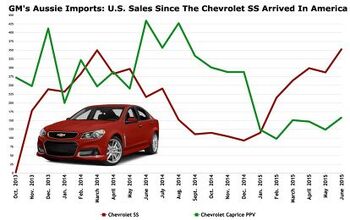Chart Of The Day: The Chevrolet Volt's Sales Challenge
Is the Chevy Volt a flop? It’s a question that plenty of folks both inside the industry and beyond seem awfully curious about, and one that I’ve tried to stay away from until we had some strong data to go on. And with nine months of 2011 under our belt, we’re starting to get a sense of where the Volt is going… and it’s not been all reassuring news. Jalopnik notes that such unloved GM models as the Buick Lucerne and Chevy Avalanche outsold the Volt last month, but failed to look at the important stuff: production as compared to deliveries, and inventory. Jalopnik does quote a Cars.com inventory figure of 2,600 Volts on dealer lots, although the latest data we have from Automotive News [sub] shows 1,400 units in the national inventory as of September 1… which at that point constituted a 121-day supply. Add in the 1,644-unit differential between Volts built and Volts sold in September, and the estimated Volt inventory across the nation should be closer to 3,000 units. We will be sure to update when AN gets new inventory numbers, but for now, the signs aren’t promising.
For one thing, it doesn’t seem likely that many Volts are being diverted from the Detroit-Hamtramck factory for sale in Europe. After all, only 10,000 Opel-branded Ampera versions will even be sold in the 2012 model-year, and European Volt volume could be even lower as the model will only be available in 50 European dealerships. In any case, with the European launch of both vehicles starting in November, GM is probably only just shipping the several-hundred Europe-bound Volts and Amperas now. In other words, it’s up to the US market to soak up the up-ramped production volume of Volts. As you can see in the top graph, production ceased in June as workers upgraded the lines for higher volume, which jumped from the 600-800 range up to the mid-2,000 unit range starting in August. What’s interesting, if you look at the numbers cumulatively (see graph below), that zero-production month actually corrected a slow divergence between the production and delivery lines. In other words, slowing production might have been a better move than ramping it up.
So, why did GM bump Volt volume? Well, more volume could eventually come in from overseas market, for one. And in the post-ramp-up period, US deliveries are climbing… just nowhere near fast enough to keep up with demand. Which is why inventory levels are climbing. Meanwhile, if you keep a close eye out, you might find more anecdotal evidence that the Volt’s sales issues are about a shortage of demand, not supply: for example, Oregon Public Broadcasting story recently ran a story on EV rescue training, which noted
About 40 Oregon first responders took part in this training session in Salem.
John Brown with the Crescent Fire District in central Oregon checks out a brand new Chevy Volt, which runs 35 miles on a battery before switching to a traditional gas engine.
“Nice vehicle. Creates headaches for us.”
For now, if Brown does respond to an accident involving a Chevy Volt, it would be, well, a shock. The dealership that loaned this car for the training session says after a month on the lot, it has yet to sell a single one.
And with Nissan Leaf sales handily outstripping deliveries of Volts, 7,199 to 3,895 (Nissan does not break out inventory data to AN), it’s no wonder the “Volt is losing the EV race” storyline is all over the media. GM’s response to that line of thinking comes from spokesman Rob Peterson, who tells Insideline
Nissan’s sales target is 25,000 Leafs in 2011. (Their sales) should be higher than ours. Our target is to deliver 10,000 (Volts) and we’re on target to reach that goal. Only 1 in 3 of the 2,100 dealers selling Volts have one in stock, with nearly 1,700 in transit. The pipeline from plant to dealership is filling up, making deliveries much more fluid.
Which is another way of saying it’s still to early to tell of the Volt will find consistent demand in the marketplace… although the “one in three dealers” thing is a bit disingenuous. After all, GM launched in EV-friendly states first, which means they likely already have access to a lot of their market. Still, sales are trending upwards, and from here on out, the “supply constrained” argument won’t fly… so the next few months will be key to determining real demand for the Volt. And though GM may only be planning on 10k Volt deliveries this year, the Obama Administration is banking on 15k units this year… and a whopping 120k units in 2012. In fact, the Obama Administration is relying on GM selling over half a million Volts by the end of 2015, in order to meet its “million plug-in cars on the road” goal. Given how much work the Volt still has to do on the demand side in order to keep up with a 28,000 unit annualized production rate, I’d say that goal is pretty much dead on arrival. As far as GM is concerned, the Volt may not be a flop… but politically it’s well on its way towards being a bust.
More by Edward Niedermeyer
Latest Car Reviews
Read moreLatest Product Reviews
Read moreRecent Comments
- Redapple2 I gave up on Honda. My 09 Accord Vs my 03. The 09s- V 6 had a slight shudder when deactivating cylinders. And the 09 did not have the 03 's electro luminescent gages. And the 09 had the most uncomfortable seats. My brother bought his 3rd and last Honda CRV. Brutal seats after 25 minutes. NOW, We are forever Toyota, Lexus, Subaru people now despite HAVING ACCESS TO gm EMPLOYEE DISCOUNT. Despite having access to the gm employee discount. Man, that is a massive statement. Wow that s bad - Under no circumstances will I have that govna crap.
- Redapple2 Front tag obscured. Rear tag - clear and sharp. Huh?
- Redapple2 I can state what NOT to buy. HK. High theft. Insurance. Unrefined NVH. Rapidly degrading interiors. HK? No way !
- Luke42 Serious answer:Now that I DD an EV, buying an EV to replace my wife’s Honda Civic is in the queue. My wife likes her Honda, she likes Apple CarPlay, and she can’t stand Elon Musk - so Tesla starts the competition with two demerit-points and Honda starts the competition with one merit-point.The Honda Prologue looked like a great candidate until Honda announced that the partnership with GM was a one-off thing and that their future EVs would be designed in-house.Now I’m more inclined toward the Blazer EV, the vehicle on which the Prologue is based. The Blazer EV and the Ultium platform won’t be orphaned by GM any time soon. But then I have to convince my wife she would like it better than her Honda Civic, and that’s a heavy lift because she doesn’t have any reason to be dissatisfied with her current car (I take care of all of the ICE-hassles for her).Since my wife’s Honda Civic is holding up well, since she likes the car, and since I take care of most of the drawbacks of drawbacks of ICE ownership for her, there’s no urgency to replace this vehicle.Honestly, if a paid-off Honda Civic is my wife’s automotive hill to die on, that’s a pretty good place to be - even though I personally have to continue dealing the hassles and expenses of ICE ownership on her behalf.My plan is simply to wait-and-see what Honda does next. Maybe they’ll introduce the perfect EV for her one day, and I’ll just go buy it.
- 2ACL I have a soft spot for high-performance, shark-nosed Lancers (I considered the less-potent Ralliart during the period in which I eventually selected my first TL SH-AWD), but it's can be challenging to find a specimen that doesn't exhibit signs of abuse, and while most of the components are sufficiently universal in their function to service without manufacturer support, the SST isn't one of them. The shops that specialize in it are familiar with the failure as described by the seller and thus might be able to fix this one at a substantial savings to replacement. There's only a handful of them in the nation, however. A salvaged unit is another option, but the usual risks are magnified by similar logistical challenges to trying to save the original.I hope this is a case of the seller overvaluing the Evo market rather than still owing or having put the mods on credit. Because the best offer won't be anywhere near the current listing.



































Comments
Join the conversation
Sales failed to rebound and demand has been non-existent since February's Chevrolet Volt 400 disaster ... http://placeitonluckydan.com/2011/05/nascar-pulls-plug-on-chevrolet-volt-400/
Just to update this thread : http://gmauthority.com/blog/2012/08/chevy-volt-sales-continue-to-outpace-those-of-nissan-leaf/ Outpacing the leaf almost 5:1 and on course for close to the 20,000 target. With a 52 day supply, so altering production to meet demand seems to have worked as of August 2012.